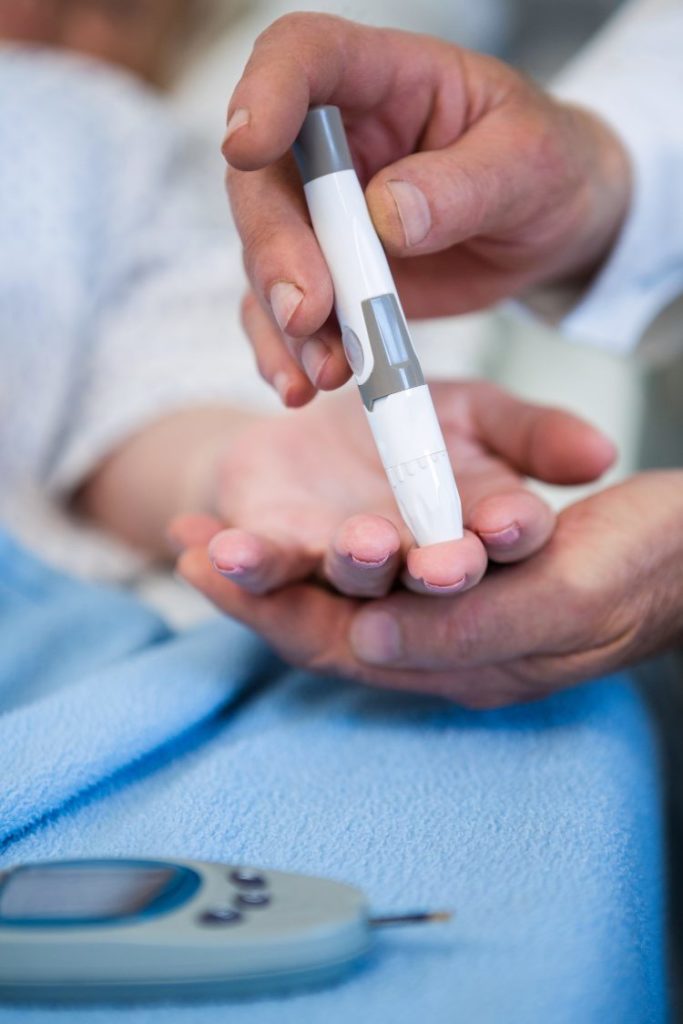Menu
Excessive alcohol use can increase someone’s risk of developing diabetes and may have harmful effects on an already diagnosed individual. An individual with diabetes can establish safe drinking limits and habits to reduce risk; however, it can be difficult for someone who suffers from alcoholism to engage in these habits. If you presume that you or someone you love is experiencing alcoholism, it is essential to seek help right away.
Diabetes develops when the affected individual’s pancreas can no longer produce insulin or when their body can no longer effectively utilize its insulin. (1) Diabetes is a chronic health condition that impacts the body’s ability to turn food into energy. (2)
Most foods, and all carbohydrates, are broken down into sugar, or glucose, which releases into the bloodstream. When the blood sugar in the body increases, the pancreas is signaled to release insulin. (2) Insulin is a hormone that allows glucose to pass from the bloodstream into the body’s cells to produce energy for the body to use. (1)
When the body cannot produce insulin or use it effectively, the glucose levels in the blood rise to an abnormal level. This heightened level of glucose in the bloodstream is known as hyperglycemia. (1) Over time, high glucose levels can create serious health issues, including heart disease, vision loss, and kidney disease. (2)
While there is currently no cure for diabetes, practices such as losing weight, eating healthy foods, and maintaining an active lifestyle can benefit an individual with diabetes. Additionally, taking medication, receiving education and support regarding diabetes self-management, and attending regular healthcare appointments can also reduce the impacts of diabetes. (2)

There are three main types of diabetes, including type 1, type 2, and gestational diabetes. (2) An individual may also develop prediabetes before becoming diabetic.
Type 1 diabetes is usually developed in children and adolescents but can occur at any age. (1) This type of diabetes accounts for 5-10% of diabetes cases, and the symptoms typically occur very quickly. (2)
Type 1 diabetes is most likely caused by an autoimmune reaction in which the body attacks itself by mistake and stops the body from producing insulin. (2) Type 1 diabetes is characterized by very little or no insulin production in the body. (1)
People who are diagnosed with this type of diabetes need to take insulin injections daily to survive. There is presently no known prevention of type 1 diabetes. (2)
Type 2 diabetes is usually developed over many years and diagnosed in adulthood. (1) However, an increasing number of children, teens, and young adults are experiencing type 2 diabetes diagnoses. Approximately 90-95% of individuals with diabetes have this type, and the symptoms may sometimes go unnoticed. (2)
Type 2 diabetes is characterized by the body’s inability to effectively use the insulin that it produces and maintain normal blood sugar levels. (2) Maintaining a healthy lifestyle, which includes regular physical activity and healthy eating habits, can prevent or delay the development and symptoms of this type of diabetes. However, most individuals with type 2 diabetes will eventually require oral drugs or insulin to regulate glucose levels in the bloodstream. (1)
Gestational diabetes occurs during pregnancy in women who have never had a previous diagnosis of diabetes. (2) This type of diabetes is characterized by high blood glucose during pregnancy and can create complications for the mother and her child. (1)
Gestational diabetes typically goes away after the baby is born but increases the mother’s and child’s risk of developing type 2 diabetes later in life. (1) The child is also more likely to experience obesity as a child or teen. (2)
Over 1 out of 3, or 88 million, United States adults have prediabetes, and over 84% of these individuals are unaware that they have it. Prediabetes is characterized by heightened blood sugar levels that are not yet high enough for a type 2 diabetes diagnosis. (2)
Prediabetes can increase an individual’s risk of developing type 2 diabetes, heart disease, and stroke. Fortunately, making and maintaining healthy lifestyle changes can ultimately reverse prediabetes. (2)
Type 1 and type 2 diabetes share some early signs and symptoms, including: (3)
Symptoms of type 1 diabetes include: (3)
Symptoms of type 2 diabetes usually show up after glucose in the body has been high for a long time. These symptoms include: (3)
There are typically no symptoms of high blood sugar during pregnancy. A woman with gestational diabetes may experience an increase in thirst or more frequent urination. (3)
Gestational diabetes occurs during pregnancy in women who have never had a previous diagnosis of diabetes. (2) This type of diabetes is characterized by high blood glucose during pregnancy and can create complications for the mother and her child. (1)
Gestational diabetes typically goes away after the baby is born but increases the mother’s and child’s risk of developing type 2 diabetes later in life. (1) The child is also more likely to experience obesity as a child or teen. (2)
The exact cause of type 1 diabetes is not known. However, it is known that the immune system, which, when functioning normally, fights harmful bacteria and viruses, attacks and destroys the cells in the pancreas that produce insulin in type 1 diabetes. Little or no insulin levels in the body causes sugar to build up in the bloodstream rather than transporting to the cells. (4)
Type 1 diabetes may be caused by a combination of genetic and environmental factors. Exactly what these factors are is unclear; however, weight is not believed to be a cause of type 1 diabetes. (4)
Prediabetes and type 2 diabetes are characteristic of the cells’ resistance to the action of insulin and the pancreas’ inability to make enough insulin to overcome this, causing sugar to build up in the bloodstream. Prediabetes can eventually lead to type 2 diabetes. (4)
The exact cause of prediabetes and type 2 diabetes is uncertain. Like type 1 diabetes they are likely caused by a combination of genetic and environmental factors. Weight is strongly linked to the development of type 2 diabetes; however, not everyone with type 2 diabetes is overweight. (4)
When a woman is pregnant, her placenta produces hormones that will sustain her pregnancy. These hormones also make the woman’s cells more resistant to insulin. In most cases, her pancreas will produce enough extra insulin to overcome the resistance. Unfortunately, in some cases, her pancreas is unable to do so. This inability to create enough insulin causes an increase in sugar in the bloodstream, leading to gestational diabetes. (4)
Even though the exact cause of type 1 diabetes is unknown, some factors may be present in an individual that can place them at an increased risk. These include: (4)
While the exact cause of prediabetes and type 2 diabetes is unknown, specific factors may increase risk. These factors include: (4)
Some women are at greater risk of developing gestational diabetes than others. Risk factors include: (4)
In addition to the risk factors mentioned above, alcohol use can also increase an individual’s risk of developing type 2 diabetes. While studies show that drinking in moderation can lower the risk of developing diabetes, drinking alcohol in excess can increase someone’s likelihood. (5)
Moderate drinking refers to one drink a day for women of all ages and men over 65 and two drinks a day for men younger than 65. Drinking this amount can be beneficial. However, drinking an excessive amount of alcohol can cause chronic inflammation of the pancreas, which impacts its ability to secrete insulin and can eventually lead to diabetes. (5)
Additionally, it is difficult for the liver to engage in multiple functions at once. When alcohol is consumed, the liver chooses to metabolize the alcohol instead of maintaining blood sugar, leading to hypoglycemia, and ultimately diabetes. (6)

Heavy alcohol consumption is not only a risk factor for developing diabetes. It can also be detrimental to someone who already has diabetes. Drinking alcohol can cause blood sugar to rise or fall and is loaded with calories. (7)
Excessive alcohol use can also affect diabetes by:

Individuals who have diabetes or prediabetes, and drink alcohol, should engage in the following practices: (7)
Signs and symptoms of alcoholism may include: (9)
If you or a loved one are struggling with alcoholism and need help there are many addiction treatment centers available to treat patients who have comorbidity with Alcohol Use Disorder and Diabetes. Please feel free to reach out to one of our addiction specialists for more information on finding the right treatment prorgam.
What is diabetes? (2020). International Diabetes Federation. https://www.idf.org/aboutdiabetes/what-is-diabetes.html
What is Diabetes? (2021, November 16). Centers for Disease Control and Prevention. https://www.cdc.gov/diabetes/basics/diabetes.html
Early Signs and Symptoms of Diabetes. (2003, February 14). WebMD. https://www.webmd.com/diabetes/guide/understanding-diabetes-symptoms
Diabetes – Symptoms and causes. (2020, October 30). Mayo Clinic. https://www.mayoclinic.org/diseases-conditions/diabetes/symptoms-causes/syc-20371444
Diabetes: Does alcohol and tobacco use increase my risk? (2020, July 11). Mayo Clinic. https://www.mayoclinic.org/diseases-conditions/type-2-diabetes/expert-answers/diabetes/faq-20058540
Medication & Treatments Alcohol & Diabetes. (2020). American Diabetes Association. https://www.diabetes.org/healthy-living/medication-treatments/alcohol-diabetes
Ambardekar, MD, N. (2001, October 25). Diabetes and Alcohol. WebMD. https://www.webmd.com/diabetes/guide/drinking-alcohol
Emanuele, N. (1998). Consequences of Alcohol Use in Diabetics. National Center for Biotechnology Information. https://www.ncbi.nlm.nih.gov/pmc/articles/PMC6761899/
Alcohol use disorder – Symptoms and causes. (2018b, July 11). Mayo Clinic. https://www.mayoclinic.org/diseases-conditions/alcohol-use-disorder/symptoms-causes/syc-20369243
Please fill out the following form to contact Sober Partners® by email, immediately!
Sober Partners
We firmly believe that the internet should be available and accessible to anyone, and are committed to providing a website that is accessible to the widest possible audience, regardless of circumstance and ability.
To fulfill this, we aim to adhere as strictly as possible to the World Wide Web Consortium’s (W3C) Web Content Accessibility Guidelines 2.1 (WCAG 2.1) at the AA level. These guidelines explain how to make web content accessible to people with a wide array of disabilities. Complying with those guidelines helps us ensure that the website is accessible to all people: blind people, people with motor impairments, visual impairment, cognitive disabilities, and more.
This website utilizes various technologies that are meant to make it as accessible as possible at all times. We utilize an accessibility interface that allows persons with specific disabilities to adjust the website’s UI (user interface) and design it to their personal needs.
Additionally, the website utilizes an AI-based application that runs in the background and optimizes its accessibility level constantly. This application remediates the website’s HTML, adapts Its functionality and behavior for screen-readers used by the blind users, and for keyboard functions used by individuals with motor impairments.
If you’ve found a malfunction or have ideas for improvement, we’ll be happy to hear from you. You can reach out to the website’s operators by using the following email
Our website implements the ARIA attributes (Accessible Rich Internet Applications) technique, alongside various different behavioral changes, to ensure blind users visiting with screen-readers are able to read, comprehend, and enjoy the website’s functions. As soon as a user with a screen-reader enters your site, they immediately receive a prompt to enter the Screen-Reader Profile so they can browse and operate your site effectively. Here’s how our website covers some of the most important screen-reader requirements, alongside console screenshots of code examples:
Screen-reader optimization: we run a background process that learns the website’s components from top to bottom, to ensure ongoing compliance even when updating the website. In this process, we provide screen-readers with meaningful data using the ARIA set of attributes. For example, we provide accurate form labels; descriptions for actionable icons (social media icons, search icons, cart icons, etc.); validation guidance for form inputs; element roles such as buttons, menus, modal dialogues (popups), and others. Additionally, the background process scans all the website’s images and provides an accurate and meaningful image-object-recognition-based description as an ALT (alternate text) tag for images that are not described. It will also extract texts that are embedded within the image, using an OCR (optical character recognition) technology. To turn on screen-reader adjustments at any time, users need only to press the Alt+1 keyboard combination. Screen-reader users also get automatic announcements to turn the Screen-reader mode on as soon as they enter the website.
These adjustments are compatible with all popular screen readers, including JAWS and NVDA.
Keyboard navigation optimization: The background process also adjusts the website’s HTML, and adds various behaviors using JavaScript code to make the website operable by the keyboard. This includes the ability to navigate the website using the Tab and Shift+Tab keys, operate dropdowns with the arrow keys, close them with Esc, trigger buttons and links using the Enter key, navigate between radio and checkbox elements using the arrow keys, and fill them in with the Spacebar or Enter key.Additionally, keyboard users will find quick-navigation and content-skip menus, available at any time by clicking Alt+1, or as the first elements of the site while navigating with the keyboard. The background process also handles triggered popups by moving the keyboard focus towards them as soon as they appear, and not allow the focus drift outside it.
Users can also use shortcuts such as “M” (menus), “H” (headings), “F” (forms), “B” (buttons), and “G” (graphics) to jump to specific elements.
We aim to support the widest array of browsers and assistive technologies as possible, so our users can choose the best fitting tools for them, with as few limitations as possible. Therefore, we have worked very hard to be able to support all major systems that comprise over 95% of the user market share including Google Chrome, Mozilla Firefox, Apple Safari, Opera and Microsoft Edge, JAWS and NVDA (screen readers).
Despite our very best efforts to allow anybody to adjust the website to their needs. There may still be pages or sections that are not fully accessible, are in the process of becoming accessible, or are lacking an adequate technological solution to make them accessible. Still, we are continually improving our accessibility, adding, updating and improving its options and features, and developing and adopting new technologies. All this is meant to reach the optimal level of accessibility, following technological advancements. For any assistance, please reach out to